Climate urgency
The remaining carbon budget is shrinking faster than anticipated, less than 6 years are left to cross 1.5°C with 50% probability. Limiting global heating to 1.5°C or even below 2°C is almost getting out of reach. Every minute we wait, we add CO2 to the atmosphere, further aggravating heating and bringing us closer to the chance of triggering a tipping cascade. If the climate system tips, heating would continue almost irrespective of what we do. Runaway heating may lead to unimaginable consequences to society: mass starvation, droughts, heat waves unbearable to the human body, sea level rise, and conflicts over basic resources, like food and water. But it is not yet too late; what we do now can change the path of history. And we will have to do it fast.
It is thus of uttermost importance to limit cumulative CO2 emissions to as low as possible. This can only be achieved by stopping burning fossil fuels as soon as possible.
Energy transition challenge
Eating less meat and changing agricultural practices are important to reduce land-use based CO2 emissions and other greenhouse gases. They require first and foremost a behavioral change, but minimal physical investments. From a physical perspective, they can be achieved almost overnight. If we, as society, finally acknowledge the urgency of the climate crisis, we could achieve a dietary shift very fast.
Not so for the energy transition: we are dependent on fossil fuels in all areas of modern life: food, housing, mobility, industry, services, etc. Switching to a renewable energy system requires energy and materials to build the required renewable energy infrastructure. It is not yet there, we have to first construct it and the only way to do this is by using energy from the current fossil energy system. This is a challenge, as we have to eliminate CO2 emissions as fast as possible and at the other hand have to rely on fossil emissions to be able to do so.
Speed matters: the more fossil energy we invest today in building renewable infrastructure—predominantly solar—, the faster the transition can be achieved and the lower overall emissions. But also it matters in what we invest these additional emissions, because this has a critical influence on the transition speed.
Solar potential
Why solar? The Earth is sunbathing. Almost all useful energy originates from our sun. There are some very small energetic contributions from planetary motion, inducing the movement of large water bodies (tides), and geothermal heat flux from the Earth's core. But everything else, and the dominant share, comes from the sun. Solar energy is transformed into many forms of energy and powers basically all Earth system processes. It evaporates water from the oceans feeding the water cycle; it drives winds; it lets biomass grow. With every conversion in the Earth system, part of the useful energy is lost as low temperature heat and ultimately, all energy is radiated back to space as heat.
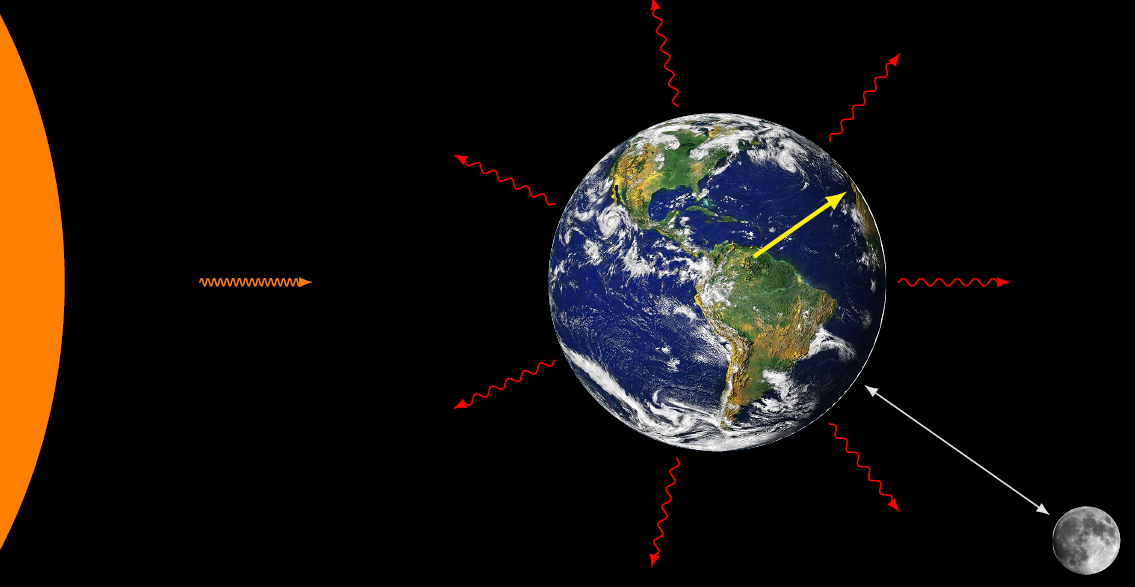
If we, as global society, want to use parts of these renewable energy fluxes the useful energy is then missing elsewhere in the Earth system. Scale matters. Up to a certain threshold, all renewable resources can be used for our purpose, without disturbing the functions of the Earth system. However beyond, it would induce changes with the potential to destabilize the integrity of the system. Such limits have been defined as the planetary boundaries: staying within these boundaries will keep the Earth system in a Holocene-like state, whereas transgressing even one of them risks the chance of destabilizing the system and moving it outside the habitable range for us humans.
Considering planetary boundaries and the physical availability of renewable energy fluxes in the Earth system, the appropriable renewable energy potentials have been defined. And they provide a very clear picture: none of the renewable energy forms is able to provide humanity's energy demand of today alone, except for direct solar energy conversion. While it may sound one-sided, it is also logical. Using the sun directly is most efficient per unit of area and when harvesting it on the surface of the already built environment—building envelopes, mobility areas, etc.—it has minimal impact on biodiversity and other essential Earth systems.
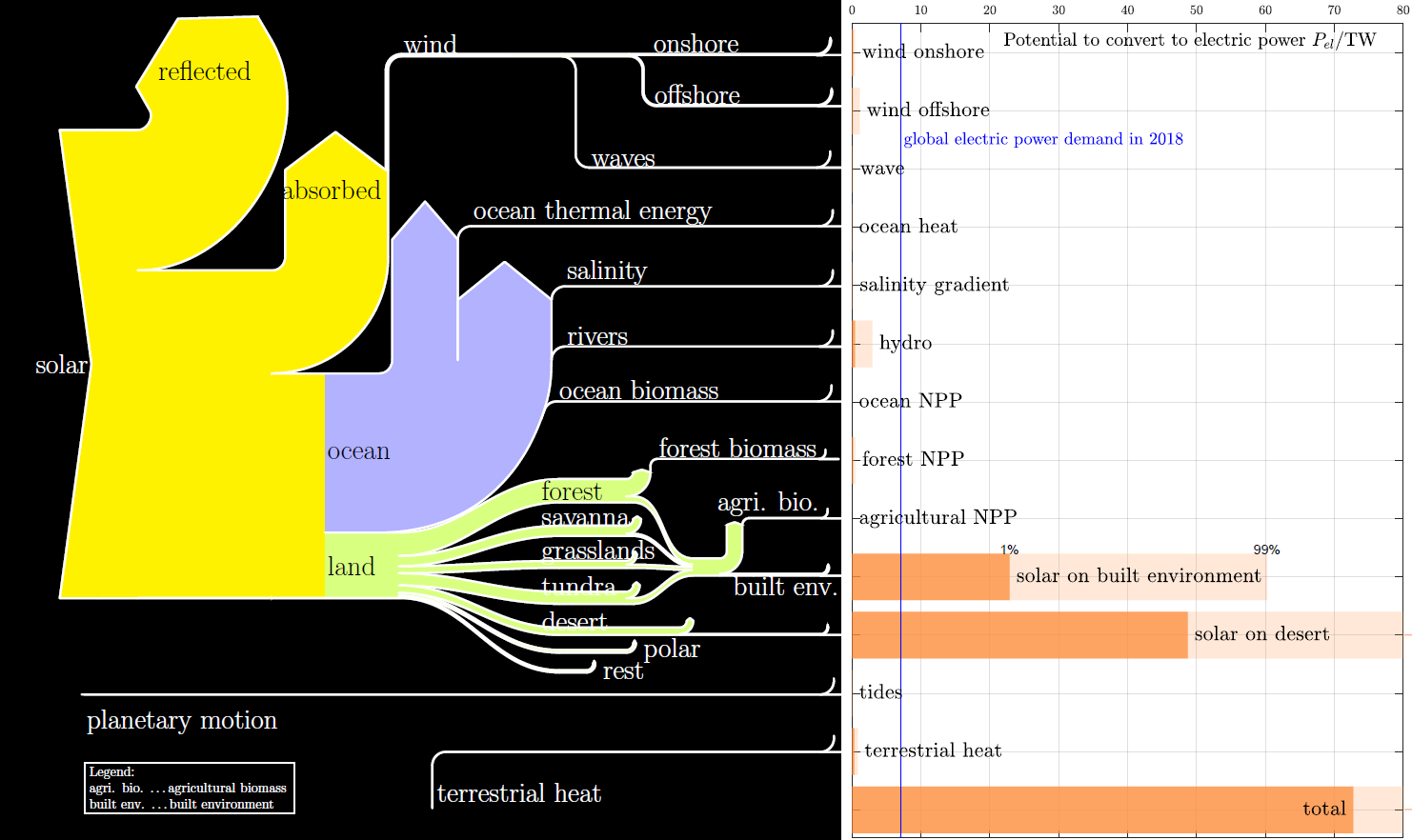
Wind has a substantially lower potential, because the conversion from solar energy to wind is very inefficient and wind farms need to cover large areas to harvest it. Wind turbines do obstruct and interfere with wildlife in these areas: killing birds and bats flying through the rotors, and generating noise that impact both life on land and in the sea. And large scale deployment of wind turbines chances wind patterns because they extract the energy driving winds over the land. This has a consequence on precipitation patterns and weather regimes. Agriculture is already driving multiple planetary boundaries outside their safe limit and feeding a still growing world population within planetary limits is challenging. Consequently, there is almost no potential to increase bioenergy use beyond the current use of residues from food production and forestry. On the contrary, bioenergy will have to decline, as some uses (like agro-fuels) are unsustainable. Hydro power has reached a global limit in capacity, it may slightly, but insignificantly increase. Besides that, dams in rivers have a large impact on the aquatic ecosystem and sediment transport.
Geothermal energy is also limited by the gradient of the heat flux from the Earth's core to the surface. It may be useful for district heating in colder areas and for other energy uses in specific locations. But large scale application of deep geothermal would accelerate the cooling of the Earth core with unknown consequences.
Other renewables—like tides, salinity gradients, or ocean heat recovery—have a very limited potential and may only make sense on a very local scale.
Consequently, the energy future will be solar harvested on the sealed surface of the already built environment.
Energy investments
Producing products requires energy. Solar panels have today an energy payback time—this is the time the panel needs to operate to provide as much energy as was used for its production—of less than 2 years (depending on the location). If we invest fossil energy to build one solar panel and install it, the panel will provide enough energy to produce another panel in less than 2 years. And then the two panels would provide energy for producing another 2 panels in again the same time. If all the energy harvested from solar panels is used to produce more solar panels, the global solar system will double every 2 years.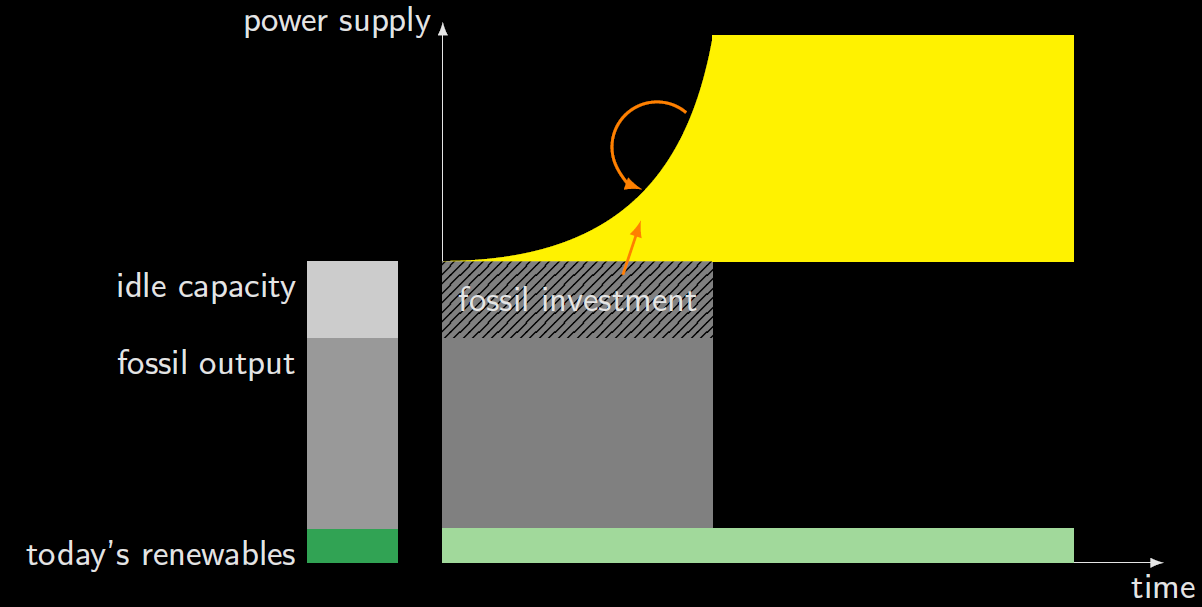
Exponential growth has peculiar dynamic, often rather difficult for us to grasp. If we start with one panel and do as described above, the growth would be still exponential, however so slow in the beginning that it takes centuries to replace the current fossil system. We can speed up this process by providing more fossil "seed" investments in the beginning and keep the fossil investments during the transition. Then the exponential growth is much faster.
The current fossil system does not operate at full speed today. There is some idle capacity in fossil power plants, which has to do with market dynamics, redundancy, and maintenance. In principle, this idle capacity is available to provide fossil investments without building a single new fossil power plant (if one would consider expanding the fossil system first, then we also have to account for the energy investments in fossil infrastructure, which will phase the same challenge). It turns out that, in theory, a transition to solar energy is energetically feasible within less than 5 years, if all idle fossil capacity is used as investments and no solar yield replaces fossil output during the transition.
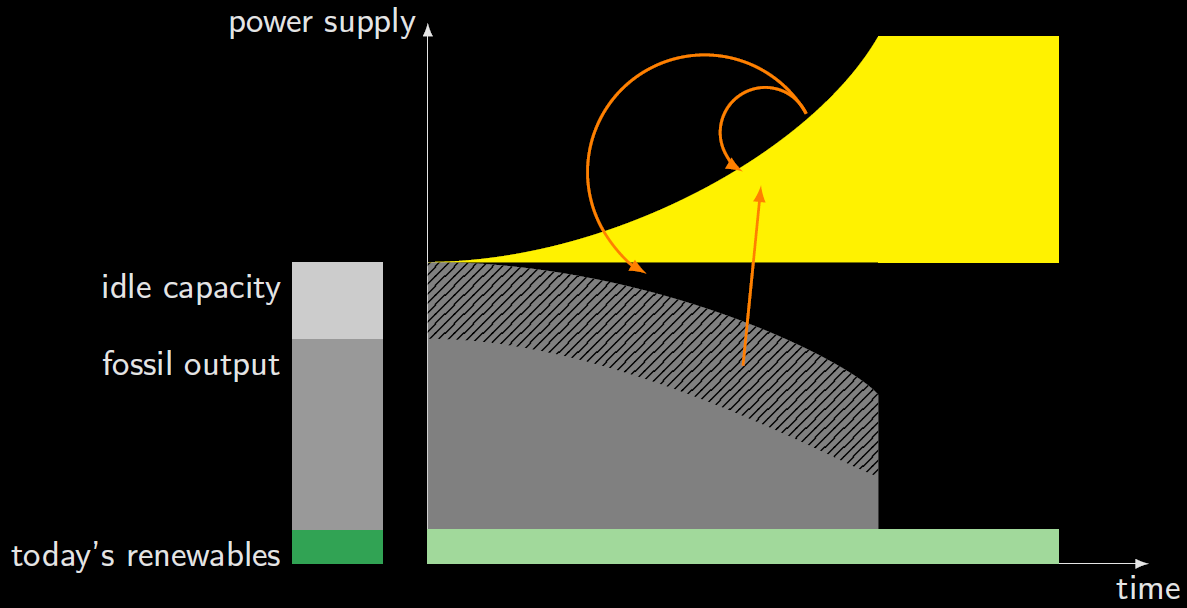
Storage losses, energy investmetns, and materials
Building and operating storage options need additional energy investments. For one thing, energy for building the storage devices depend on the materials contained in the devices as well as the size of the storage desired. Electro-chemical batteries, for instance, require special materials that can store the charge of electrons in their structure, often being rare and "critical" materials such as Li, Co, Mn, graphite, P, Nb. Pumped hydro storage and similar concepts, require traditional bulk materials such as steel and concrete and imply lots of earthworks. Here the materials are not critical in terms of availability, but in terms of the quantities and energy required. Storing synthetic fuels does not require much equipment (we already have lots of storage tanks for fossil fuels), however, for producing and converting them we need electrolyzers and fuel cells, which contain platinum group metals, rare earth elements, and other elements also required in batteries.
But energy storage is also costly in another aspect: to compensate for storage losses, we need to build more solar panels in the first place, again requiring energy and materials and slowing down the maximum speed of the transition.
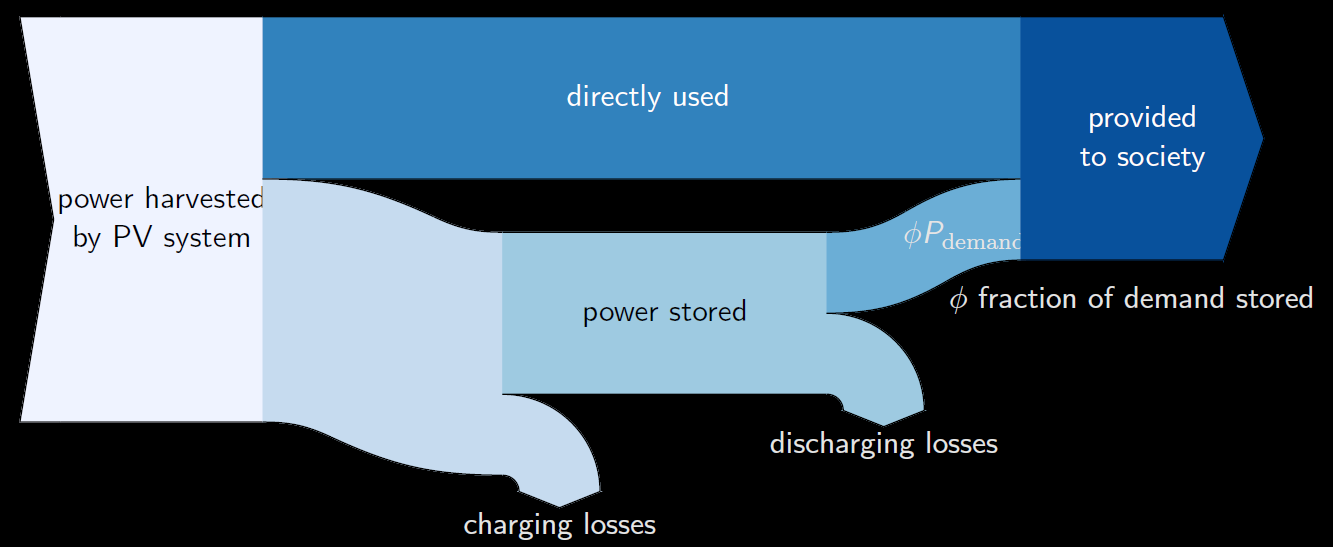
Consequence: less storage is critical
Considering the energy investments needed to build storage alongside solar shows that even with small amounts of storage to balance solar supply, climate risks increase significantly. It is thus absolutely critical to reduce the amount of storage that we want to build and the amount of energy we want to provide through storage.
It requires a paradigm shift—similar to reducing meat consumption—but saves materials and energy to the extent of enabling a fast transition to stabilizing our climate.
Discover some ideas on how this could work and feel in the blog section.
 Sunflower Society
Sunflower Society